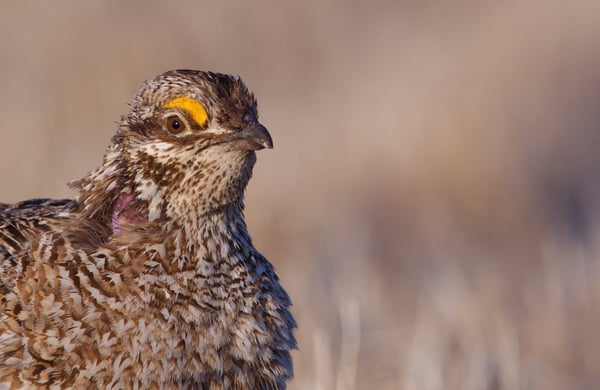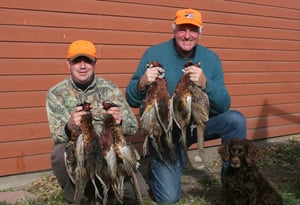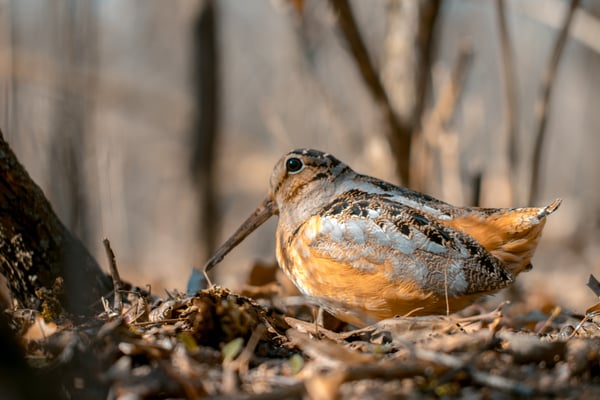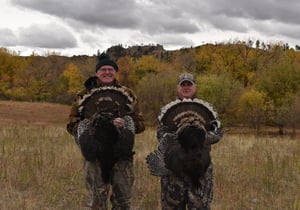With the pandemic still at our doorstep now is a good time to get afield for some upland hunting. Social distancing is easy. Hunting dogs are not a vector. Now is a good time to work out the kinks in your legs, undo some of that home-bound carbo loading, and give your canine hunting companion a chance to unleash some of those hunting instincts!
This time of year the weather is often mild, or at least not harsh, and there are ample opportunities to hunt several species. For example, Nebraska has designated an upland slam: northern bobwhite, ring-necked pheasant, prairie chicken, and sharp-tailed grouse.

The following are a few examples of species targeted in upland hunting and where to find them.
Wild Pheasants
The Ringed-necked Pheasant was introduced into the US several times, and has fared well in the northern and much of the western US. The males are very colorful, the females who nest on the ground, cryptic. Often only roosters are shot, leaving hens to reproduce. They are hardy birds, who fly well, but also run very well. This presents a challenge in hunting them—putting the bird to wing.

The ideal habitat of wild pheasants is a mixture of types: fallow fields with natural grass-forb vegetation, small agriculture fields with waste grain, cover such as windrows, fencerows, uncultivated miscellaneous spots, and cattails in wet places. Hens nest on the ground and need surrounding vegetative structure for cover from predators, and low vegetation with insects for the rapidly growing chicks.
Land use practices which negatively impact habitat include: clean farming with little waste grain or non crop vegetation, fall disking, and excessive pesticides. (I recommend always referencing your states "best management practices" before using pesticides!) Meanwhile, agency programs to protect habitat, such as the Conservation Reserve Program have had a positive impact.
American Woodcock
Woodcock are strange looking birds, to me anyway. Taxonomically they are included in the shore bird group, but inhabit upland areas. They have a long bill with a flexible tip with which they extract their favorite prey: earthworms. Woodcock have a most interesting mating display. The male selects an opening to do his dance. He flies vertically making a twittering sound with his wings, then lands and makes a frog-like call—peent-peent. Different strokes for different critters! Their range is the eastern US and Canada, breeding mostly in the northern US and southern Canada, and wintering in the southern US. At night they forage in open fields, while their winter day-time habitat is thickets, and it seems the thicker the better. I often flush them in moist spots, which is likely good worm habitat. They hold well for a pointing dog. Brittany spaniels are often the dog of choice, although other good pointing breeds include the English setter, and German short-haired pointer.

Fall Turkeys
The wild turkey, America’s icon, is found throughout the continental US and in southern Canada, and while populations have previously been in decline, restoration efforts have been quite successful. The turkey’s ideal habitat is a mixture of mature woods, grass-forb habitat, and openings such as food plots or small grain fields. In traditional turkey states along the east coast and elsewhere, particularly where turkeys are abundant and farmers don’t like them, there is fall turkey hunting. Now, hunting long beards in the spring is a hoot—with the gobble the inspiration—but fall hunting is also fun!

Wild turkeys have a social structure in the fall. Gobblers run in bachelor groups, while the hens and their poults gather together. These flocks associate together and vocalize to each other to maintain contact. Intruding on that structure is the challenge. Sometimes you can call a stray individual, or even a whole flock. But you can up your odds for success if you can bust up a flock. Separated turkeys, especially young ones are eager to get back together, and you can imitate the hen they are looking for.
Flushing dogs such as specially bred turkey dogs, or Springer or Boykin spaniels, are sometimes used to facilitate this flock bust up. Ideally they scent the mobile flock, track, and run into them flushing birds in different directions and barking. The hunter goes in, hides the turkey dog, and vocally pleads with yelps or kee-kees with lonesome turkeys seeking feathered company.
A Word of Caution
Fall hunting of any sex and age turkey is suitable if the population is doing well, and recent hatches have been good. But there have been population declines in places. If this is the case in your region you need to call off the fall hunt to allow those populations to recover. You can read more about how some wildlife biologists fear the coronavirus could result in over-hunting this turkey season in this blog post.
If turkey populations in your neck of the woods are healthy and thriving, now is a good time to take a break from the COVID limitations and political bombardment, and go to the woods for some fall fun.
About the Author: Dr. James G. Dickson is an award-winning author, researcher, wildlife biologist, and professor. He, with help from colleagues, produced the comprehensive and award-winning books on: Wildlife of Southern Forests: Biology and Management, and The Wild Turkey: Biology and Management, called the turkey bible. He is Scientist Emeritus, USDA Forest Service, Southern Research Station. Email him at jgdickson14@gmail.com
*This post was written by guest blogger. The views within it do not necessarily represent those of WoodsCamp Technologies or the American Forest Foundation.


We want to hear from you.